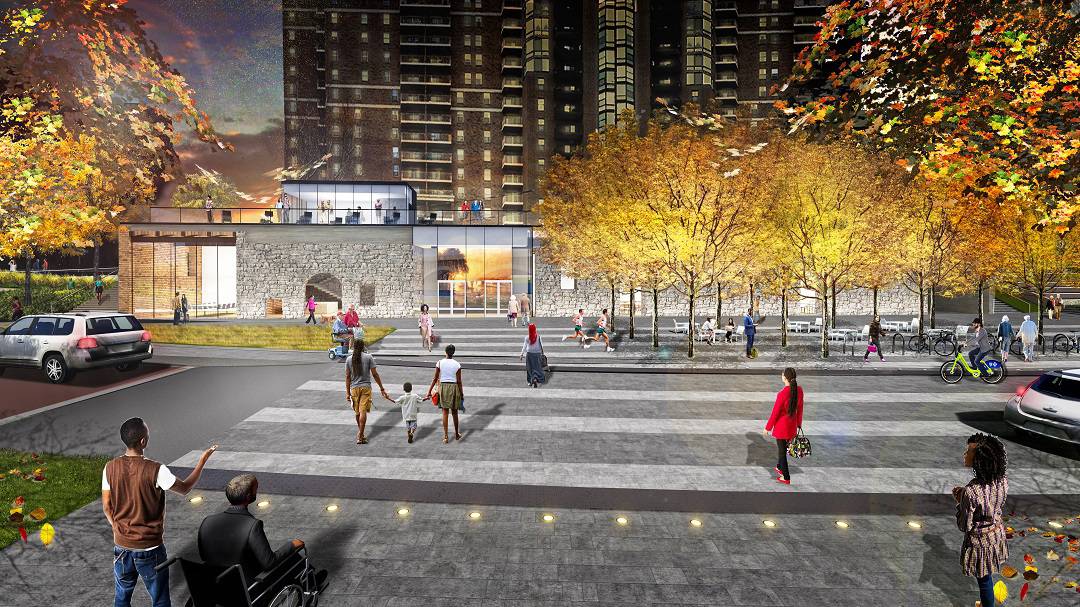
Work begins in August to unlock mill remnants featured in Water Works
Minneapolis, Minn. – The Minneapolis Park and Recreation Board (MPRB) and Minneapolis Parks Foundation today announced the start of new archaeological work in preparation for construction of Water Works, a transformative riverfront park project within Mill Ruins Park.
Work begins soon on, and adjacent to, the old Fuji-Ya building, located at the corner of 1st Street and 5th Avenue S, near the Stone Arch Bridge and West River Parkway. Archaeological exploration is necessary to fully locate and assess the condition of the former Bassett, Columbia and Occidental mill remnants. The mill walls are planned to be integrated into a new indoor riverfront pavilion and outdoor gathering spaces included in the updated Water Works design.
In September 2017, careful deconstruction of the Fuji Ya building begins. Full-scale construction of Water Works will take place in 2018. The first phase of Water Works, called the Mezzanine Phase, will be complete and open to the public in 2019.
“We’re incredibly excited to have this opportunity to explore, unearth and adapt fascinating pieces of buried Minneapolis history for a new era of riverfront vitality,” says Jayne Miller, MPRB Superintendent. “These mills helped build Minneapolis into an industrial powerhouse and soon they’ll rejoin the Central Riverfront as part of its revitalization into a world-class cultural attraction.”
The Mezzanine Phase encompasses about 2.5 acres, from West River Parkway to 1st Street S, and 3rd Avenue S to Fifth Avenue S. It includes a new indoor riverfront pavilion with a food vendor, rooftop terrace and plantings, city steps overlooking the Mississippi River, outdoor play areas and gathering spaces, a connection to the Mill City Quarter woonerf and improved biking and walking connections. The Riverside Phase will follow the Mezzanine Phase and is expected to begin in 2021.
“Water Works will be a place for gathering and communing, just as Owamni Yomni or St. Anthony Falls has drawn people for millennia,” says Tom Evers, Executive Director of the Minneapolis Parks Foundation, which aligns community vision and philanthropic investment to bring parks to life and communities together. “By creating space for people and peoples to tell their stories, we’re honoring the site’s rich history even as we provide for new opportunities to connect to nature and each other for this generation and generations to come.”
The balance between park development and tree removal will be thoughtfully considered throughout construction on this project. Some trees need to be removed due to poor health, site circulation or grading, or interference with the buried cultural and historic resources that will be unearthed and showcased as part of Water Works. The site will be replanted with a diverse mix of trees using urban forestry best practices under the supervision of MPRB Arborists.
Through the Parks Foundation, the majority of Mezzanine Phase funding will be provided by philanthropic investment. In 2015, the Parks Foundation launched the RiverFirst Capital Campaign, which has to-date raised $12.3M in philanthropic gifts and commitments.
About the Minneapolis Parks Foundation
The Minneapolis Parks Foundation transforms human lives through parks and public spaces by aligning philanthropic investment and community vision. The Parks Foundation co-leads the RiverFirst Initiative with the Minneapolis Park and Recreation Board and is responsible for private fundraising and implementation of the Water Works and Great Northern Greenway River Link projects. The Parks Foundation also supports innovative Minneapolis parks projects through equity funding and champions world-class design through its Next Generation of Parks™ Event Series. Learn more at MplsParksFoundation.org.
About the Minneapolis Park and Recreation Board
The Minneapolis Park and Recreation Board is an independent, semi-autonomous body responsible for the Minneapolis park system. With 179 park properties totaling 6,804 acres of land and water, the Park Board provides places and recreation opportunities for all people to gather and engage in activities that promote health, well-being, community and the environment. Its Grand Rounds Scenic Byway, neighborhood parks, recreation centers and diversified programming have made the park system an important component of what makes Minneapolis a great place to live, play and work. More than 22 million annual visits are made to the nationally acclaimed park system, which was named the number one park system in the nation in 2013, 2014, 2015, 2016 and 2017 by The Trust for Public Land’s ParkScore® Index.

